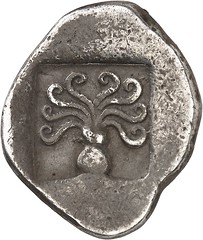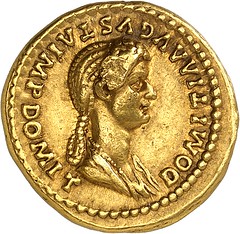
PREV ARTICLE
NEXT ARTICLE
FULL ISSUE
PREV FULL ISSUE
KUENKER AUCTION 402The Künker Spring Auction Sales 402-407 are now online. Here's a preview of catalog 402 featuring Coins from the Ancient World, including the first part of the Dr. Kaya Sayar's Collection (Greek Coins from Asia Minor). -Editor Lycia, Pamphylia and Cilicia: The Sayar Collection One of the finest collections of Greek coins from Asia Minor will be auctioned off by Künker. On sale is the first part of the Dr. Kaya Sayar Collection, including more than 500 lots with coins from Lycia, Pamphylia and Cilicia. This highlight is the prelude to the general auction of coins from the ancient world. Collecting is a passion – and you can most definitely feel this passion when browsing through catalog 402. It presents the first part of the Dr. Kaya Sayar Collection, which will be offered on 14 and 15 March 2024 at Künker in Osnabrück. The collection grew for more than 30 years. Its composer – Dr. Kaya Sayar – is one of those wonderful people who live their lives as cosmopolitans while also cherishing their roots in two home countries. Born in Istanbul, the structural engineer obtained his doctorate in Hannover (Germany), where he met many numismatic friends at the local coin club. While he considers Hannover his home town, he also loves Turkey, the country he was born in and where he spent his childhood, his youth and countless wonderful moments of relaxation. Dr. Sayar is an amateur, a lover of numismatics in the truest sense of the word. Professionally speaking, he engineered important buildings across the globe. At this point, we will limit our list to the breathtaking Barquisimeto Cathedral in Venezuela, the Mertim Tower, which was the tallest building in Turkey until 2000 at a height of 580 feet, and the extravagant water tower of the Saudi Arabian city of Medina. As a collector, Dr. Kaya Sayar was particularly interested in the Lycian landscape. With its high mountains and abundant rivers, the region exerts a unique fascination on every tourist who visits it. The extraordinary quality of the Sayar Collection is best illustrated by the fact that Wilhelm Müseler used it time and again while authoring his most recent reference work on Lycia. The coins of Lycia and those of the neighboring provinces of Pamphylia and Cilicia will come under the hammer at Künker's Spring Auction Sales 2024. Later in the year, they will be followed by the Anatolian coins of the Sayar Collection.
Lycia, Pamphylia, Cilicia Probably inspired by the Greek city of Phaselis, many Lycian dynasts issued their own coins, whose archaic charm appeals to collectors all over the world.
The indigenous language was also preserved in Pamphylia, although Greek settlers found a new home in the fertile alluvial plain. The cultures mingled, as is evidenced by deities such as And Cilicia, which was conquered by the Macedonian army in 333 BC at the Battle of Issus, is a region where many cultures and influences came together. This is also reflected by its coinage. Cilician pieces depict many motifs that seem familiar to us, and whose details reflect the influence of the Near East. This preview presents some selected pieces that illustrate the distinct character of south Turkish coinage. Attention should be drawn to the fact that Dr. Sayar exclusively bought his pieces at renowned auctions, which is why his collection contains many pieces of excellent provenance. You will repeatedly come across the names of Hans von Aulock, Theo Reuter and Edoardo Levante. No. 1: Pre- and proto-dynastic issues. Unknown dynast. Stater, around 500, unknown mint. SNG von Aulock 4041 (this specimen). Rare. Splendid patina. About extremely fine / Extremely fine. Estimate: 500 euros No. 10: Pre- and proto-dynastic issues. Unknown dynast. Stater, 500-480, unknown mint. SNG von Aulock 4054 (this specimen). Fully centered, showing the entire motif. Beautiful patina. Very fine +. Estimate: 300 euros No. 32: Ekuwemi. Stater, 480-460, unknown mint. Very rare. Splendid patina. Very fine +. Estimate: 1,000 euros No. 66: Kuprilli. Stater, 470-440, Aperlai / Apollonia or Zagaba. Extremely rare. Very fine. Estimate: 750 euros No. 95: Khinakha. Stater, 470-440, Kandyba. Probably unique. Very fine. Estimate: 2,500 euros No. 140: Kheriga. Stater, 440-430, Phellus. Very rare. Very fine. Estimate: 2,000 euros No. 144: Kherei. Diobol, 430-410, unknown mint (Kandyba?). Very rare. Fine toning. Very fine +. Estimate: 150 euros No. 164: Kherei. Stater, 430-410, Telmessus. Rare. Extremely fine. Estimate: 1,250 euros No. 208: Aruwatijesi. Stater, 390-370, unknown mint (Zagaba?). SNG von Aulock 4204 (this specimen). Splendid patina. Very fine +. Estimate: 1,500 euros No. 247: Artumpara. Stater, around 370, unknown mint (Xanthos?). Extremely rare. Very fine. Estimate: 1,500 euros No. 267: Phaselis. Stater, 167-130. Fine toning. About extremely fine. Estimate: 1,250 euros No. 359: Aspendos. Drachm, 420-360. Rare. Fine toning. Very fine to extremely fine. Estimate: 750 euros No. 489: Tarsus. Mazaios, 361-334. Stater. Very rare. About extremely fine. Estimate: 1,000 euros
Ancient Coins from Various Estates Please note that this preview focuses on particularly expensive specimens. However, estimates start as low as at 50 euros. Many lots have starting prices in the low three-digit range. No. 525: Parisii. Stater, around 60 BC. Very rare. Very fine +. Estimate: 15,000 euros No. 574: Messana / Sicily. Tetradrachm, 425-421. From Hess-Leu auction 49 (1971), No. 52. Extremely fine. Estimate: 5,000 euros No. 577: Syracuse / Sicily. Tetradrachm, 510-490. From Sir Arthur John Evans, R. Jameson and Nelson Bunker Hunt Collection. Very rare. Splendid patina. Very fine +. Estimate: 25,000 euros No. 649: Eretria / Euboea. Stater, 500-465. From the Warren Collection and the Collection of the Boston Museum of Fine Arts. Very rare. Fine toning. Very fine +. Estimate: 3,000 euros No. 669: Knossos / Crete. Stater, 330-300. Duplicate of the Bibliothèque Nationale, Paris. Very rare. Splendid patina. Very fine +. Estimate: 3,000 euros No. 677: Paros / Cyclades. Drachm, around 490-480. Rare. Extremely fine. Estimate: 6,000 euros No. 800: Marcus Antonius and Octavianus. Aureus, 41 BC, Ephesus. Purchased on 6 July 1963 at S. Boutin, Paris. Very rare. About extremely fine. Estimate: 40,000 euros No. 860: Vespasian, 69-79. Sestertius, 71, Rome. From Vinchon auction 1976, No. 46. Very rare, especially in this quality. Extremely fine. Estimate: 40,000 euros No. 879: Domitian, 81-96, and Domitia. Aureus, 82-83, Rome. From the Jameson Collection. Very rare. Very fine. Estimate: 25,000 euros No. 890: Aelius. Aureus, 137, Rome. Rare in this quality. Extremely fine. Estimate: 40,000 euros No. 937: Gordian III, 238-244. Medallion, Daldis (Lydia). Rv. Perseus walking to the left towards three sleeping Gorgons, behind a palm tree and Hypnos, in the foreground Pegasos to the left looking back and a temple of Apollo with four columns. Very rare. About extremely fine. Estimate: 15,000 euros No. 943: Trajan Decius, 249-251. Double sestertius, Rome. From Grabow list (1954), No. 233 and the Salton Collection. Showpiece of the finest style and most beautiful quality. Rare. Brown patina, slight double strike on the reverse. Extremely fine. Estimate: 20,000 euros No. 1041: Irene, 797-802. Solidus, Syracuse. Rare. Extremely fine to FDC. Estimate: 10,000 euros Auction 402 kicks off Künker's Spring Auction Sales in Osnabrück on 14 and 15 March. Five more catalogs follow. Auction 403 contains a special collection with coins and medals of popes, auction 404 the second part of the Prof. Dr. Eckhart Pick Collection of Mainz coins and medals, auction 405 an extensive collection of Regensburg issues, auction 406 the general catalog of coins and medals from medieval and modern times with a special collection on Löwenstein-Wertheim, and auction 407 contains a special collection with coins of the Austrian Emperor Franz Joseph from the estate of the internationally renowned numismatist Heinz Tursky. To order a catalog contact Künker, Nobbenburger Straße 4a, 49076 Osnabrück; phone: +49 541 / 962020; fax: +49 541 / 9620222; or via e-mail: service@kuenker.de. You can access the auction catalogs online at www.kuenker.de. If you want to submit your bid from your computer at home, please remember to register for this service in good time.
Wayne Homren, Editor The Numismatic Bibliomania Society is a non-profit organization promoting numismatic literature. See our web site at coinbooks.org. To submit items for publication in The E-Sylum, write to the Editor at this address: whomren@gmail.com To subscribe go to: https://my.binhost.com/lists/listinfo/esylum All Rights Reserved. NBS Home Page Contact the NBS webmaster 
|




















































